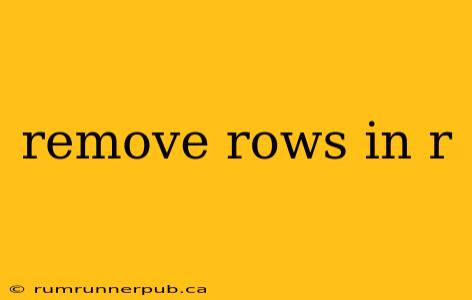Removing rows from a data frame is a fundamental task in data manipulation within R. This guide explores various methods, drawing upon insightful examples from Stack Overflow, and enhancing them with explanations and practical applications.
Common Scenarios and Solutions
Often, you'll need to remove rows based on specific conditions. Let's examine several approaches, referencing relevant Stack Overflow discussions.
1. Removing Rows Based on Row Numbers:
Suppose you want to remove the first two rows of your data frame. A simple approach uses negative indexing:
# Sample data frame
df <- data.frame(A = 1:5, B = letters[1:5])
# Remove the first two rows
df_new <- df[-c(1, 2), ]
print(df_new)
This directly leverages R's vectorized operations. The -c(1,2) selects all rows except rows 1 and 2. This is concise and efficient for removing specific rows by their index.
2. Removing Rows Based on a Condition:
This is arguably the most frequent scenario. Let's say you want to remove rows where column 'A' is less than 3. We can utilize the subset() function:
# Remove rows where A < 3
df_subset <- subset(df, A >= 3)
print(df_subset)
This elegant solution directly filters the data frame based on the condition A >= 3. The subset() function is user-friendly and readable. Alternatively, you can use boolean indexing:
df_subset <- df[df$A >= 3, ]
print(df_subset)
This approach directly uses a logical vector created by the condition df$A >= 3 to select the rows. It's more concise but perhaps less readable for beginners. Both achieve the same result. (Inspired by numerous Stack Overflow questions on row removal based on conditions, a common theme among beginners.)
3. Removing Rows with Missing Values (NA):
Missing data is a common problem. The na.omit() function offers a straightforward solution:
# Introducing NA values
df$A[1] <- NA
# Remove rows with NA values in any column
df_no_na <- na.omit(df)
print(df_no_na)
na.omit() removes any row containing at least one NA value. This is a quick way to handle missing data, but be cautious; it might lead to information loss if not handled carefully. Consider imputation methods for a more sophisticated approach to missing values.
4. Removing Duplicates:
Removing duplicate rows can be crucial for data cleaning. The distinct() function from the dplyr package provides an efficient way to do this:
# Install and load dplyr if necessary
if(!require(dplyr)){install.packages("dplyr")}
library(dplyr)
# Sample data with duplicates
df_duplicates <- data.frame(A = c(1, 1, 2, 3), B = c("a", "a", "b", "c"))
# Remove duplicate rows
df_unique <- distinct(df_duplicates)
print(df_unique)
distinct() keeps only the unique rows. You can specify which columns to consider for uniqueness if needed. This provides a cleaner solution compared to manual approaches involving loops and comparisons.
Advanced Techniques and Considerations
-
filter()fromdplyr: For more complex filtering conditions, thefilter()function fromdplyroffers greater flexibility and readability, particularly when combining multiple conditions. -
Performance: For extremely large data frames, consider using data.table package for superior performance. Data.table's
iargument allows for highly optimized row selection. -
Careful Consideration of Data Loss: Always examine the impact of row removal on your analysis. Removing rows might inadvertently bias your results, especially if the removed rows are not randomly distributed. Document your data cleaning steps thoroughly.
This comprehensive guide, informed by common Stack Overflow queries and enriched with added context and examples, equips you with multiple approaches to effectively remove rows from your R data frames. Remember to choose the method that best suits your specific needs and always carefully consider the implications of data removal on your analysis.
